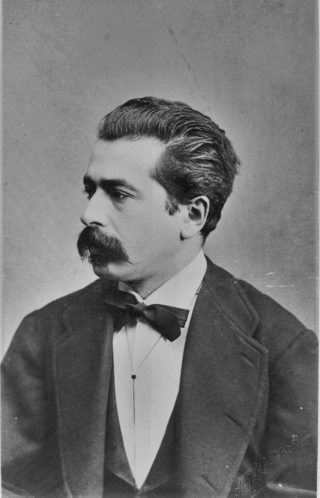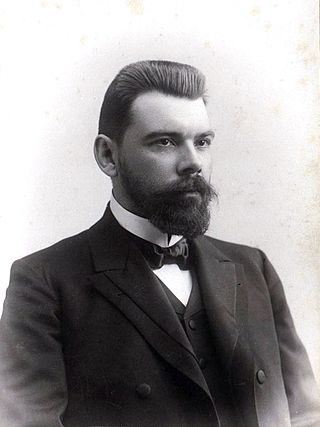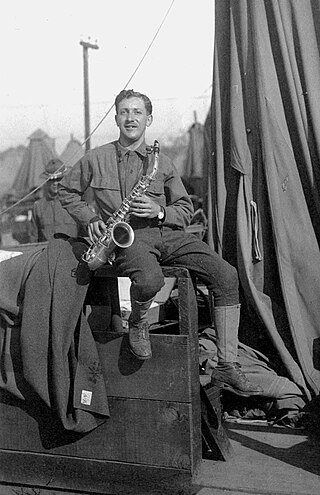Related Research Articles

In music, a cadenza, is, generically, an improvised or written-out ornamental passage played or sung by a soloist(s), usually in a "free" rhythmic style, and often allowing virtuosic display. During this time the accompaniment will rest, or sustain a note or chord. Thus an improvised cadenza is indicated in written notation by a fermata in all parts. A cadenza will usually occur over either the final or penultimate note in a piece, the lead-in, or the final or penultimate note in an important subsection of a piece. A cadenza can also be found before a final coda or ritornello.

A nocturne is a musical composition that is inspired by, or evocative of, the night.

Eugène-Auguste Ysaÿe was a Belgian virtuoso violinist, composer, and conductor. He was regarded as "The King of the Violin", or, as Nathan Milstein put it, the "tsar".

Karol Maciej Szymanowski was a Polish composer and pianist. He was a member of the modernist Young Poland movement that flourished in the late 19th and early 20th century.

Henryk Wieniawski was a Polish virtuoso violinist, composer and pedagogue, who is regarded amongst the most distinguished violinists in history. His younger brother Józef Wieniawski and nephew Adam Tadeusz Wieniawski were also accomplished musicians, as was his daughter Régine, who became a naturalised British subject upon marrying into the peerage and wrote music under the name Poldowski.

Reinhold Moritzevich Glière, born Reinhold Ernest Glier, was a Russian and Soviet composer of German and Polish descent. He was awarded the title of People's Artist of RSFSR (1935) and People's Artist of USSR (1938).

Caprice No. 24 in A minor is the final caprice of Niccolò Paganini's 24 Caprices, and a famous work for solo violin. The caprice, in the key of A minor, consists of a theme, 11 variations, and a finale. His 24 Caprices were probably composed between 1802 and 1817, while he was in the service of the Baciocchi court.
The Violin Concerto No. 1 in A minor, Op. 77, was originally composed by Dmitri Shostakovich in 1947–48. He was still working on the piece at the time of the Zhdanov Doctrine, and it could not be performed in the period following the composer's denunciation. In the time between the work's initial completion and the first performance, the composer, sometimes with the collaboration of its dedicatee, David Oistrakh, worked on several revisions. The concerto was finally premiered by the Leningrad Philharmonic under Yevgeny Mravinsky on 29 October 1955. It was well-received, Oistrakh remarking on the "depth of its artistic content" and describing the violin part as a "pithy 'Shakespearian' role."
Sergei Prokofiev began his Violin Concerto No. 1 in D major, Op. 19, as a concertino in 1915 but soon abandoned it to work on his opera The Gambler. He returned to the concerto in the summer of 1917. It was premiered on October 18, 1923 at the Paris Opera with Marcel Darrieux playing the violin part and the Paris Opera Orchestra conducted by Serge Koussevitzky. Igor Stravinsky made his debut as conductor at the same concert, conducting the first performance of his own Octet for Wind Instruments.

Alexander Fyodorovich Goedicke was a Russian and Soviet composer and pianist.

Henryk Melcer-Szczawiński was a Polish composer, pianist, conductor, and teacher. His students included composer and pianist Jadwiga Sarnecka.

Paul Kochanski was a Polish violinist, composer and arranger active in the United States.

Frederick Jacobi was a Jewish-American composer and teacher. His works include symphonies, concerti, chamber music, works for solo piano and for solo organ, lieder, and one opera.
Grande Tarantelle, Op. 67, is a tarantella written by American composer Louis Moreau Gottschalk from 1858-64. Subtitled Célèbre Tarentelle, it was first performed at the Academy of Music in Philadelphia in 1864.
Karol Szymanowski’s Violin Concerto No. 1, Op. 35, is considered one of the first modern violin concertos. It rejects traditional tonality and romantic aesthetics.

Algernon Bennet Langton Ashton was a British composer, pianist, and Professor of piano at the Royal College of Music 1884–1910.
Alfred Janson was a Norwegian pianist and composer. He was born in Oslo as the son of sculptor Gunnar Janson and pianist Margrethe Gleditsch, and was brother of journalist Mette Janson. He was first married to actress and singer Grynet Molvig and later to Berit Gustavsen. He made his piano debut in 1962. Among his early compositions is the piano piece November from 1962 and the orchestral Vuggesang from 1963. He composed the ballet Mot solen for the Bergen International Festival in 1969, and in 1991 he was the festival's principal composer.
Mythes, Op. 30 is a suite for violin and piano written by Karol Szymanowski in 1915 and premiered one year later by Paul Kochanski on violin and the composer on piano. It is dedicated to Kochanski's wife, Zofia Kochańska.
Karol Szymanowski's Violin Concerto No. 2, Op. 61 was written between 1932 and 1933 and was the composer's last major work before his death in 1937.
References
- ↑ See IMSLP.
- ↑ Lively.Arts
- 1 2 Classical Archives
- ↑ LAPHIL
- ↑ Naxos
- 1 2 Culture.pl
- 1 2 3 ArkivMusic